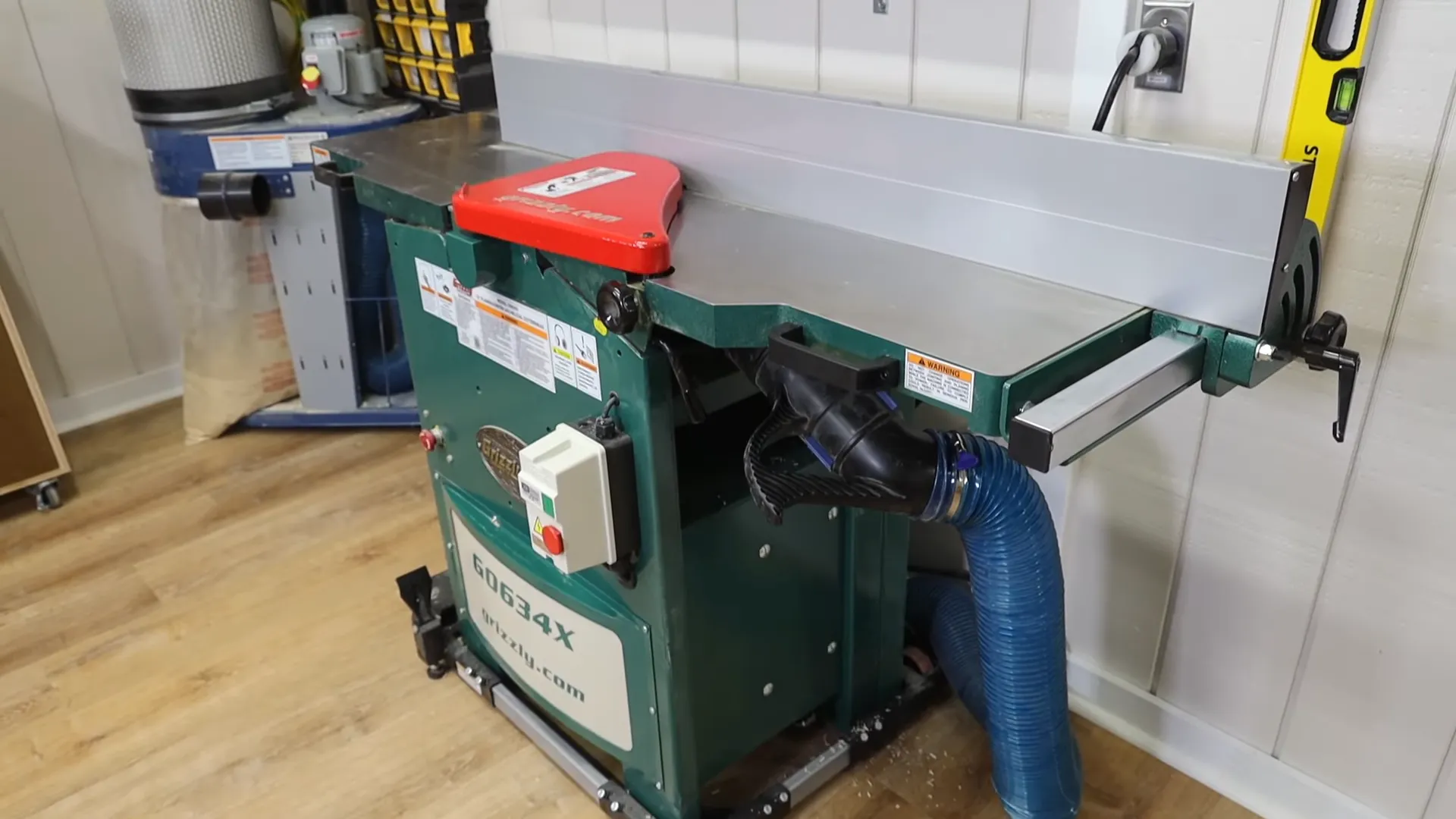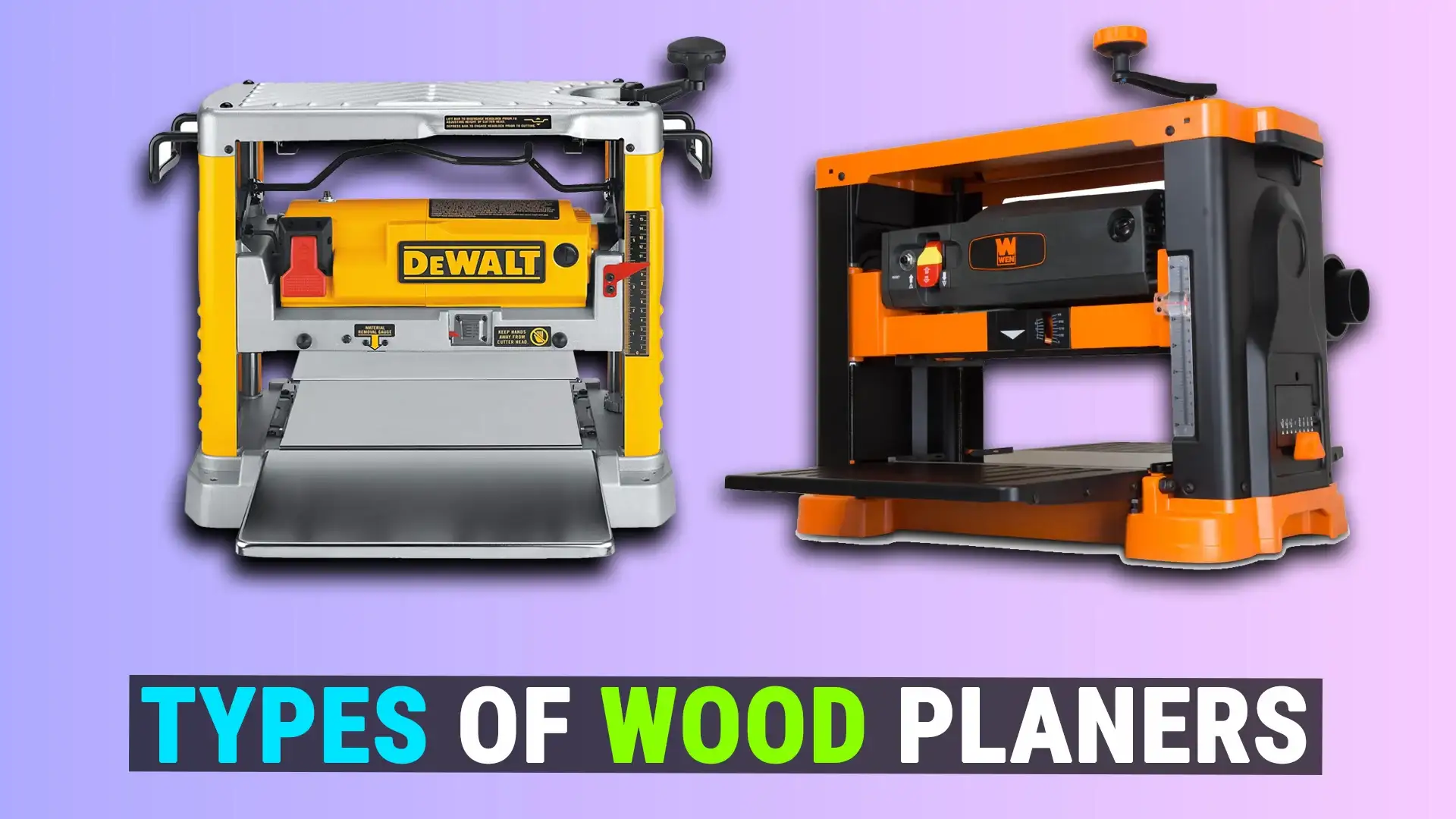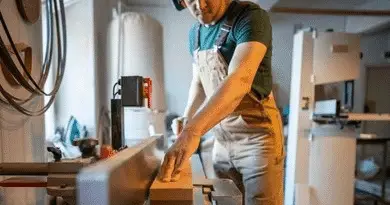Are Jointer Planer Combos Any Good? [2023]
A jointer planer combo machine, also known as a jointer planer hybrid, combines a thickness planer and jointer into one machine. This allows you to jointly and thickness plane wood in one machine, eliminating the need for two separate stand-alone machines.
Jointer planer combos have a few key features:
- Jointing table – This is the infeed table that allows you to flatten and straighten boards. It has fences to reference the face side of the board against.
- Thickness planing table – This is the outfeed table where wood passes under the cutterhead to be thickness planned to a precise dimension.
- Cutterhead – The cutterhead contains knives that plane the wood. It can be raised or lowered to control the depth of cut.
- Fence – The fence runs along the jointing table and provides a reference edge to push boards against when jointing.
- Depth stop – Allows you to preset the thickness planing depth.
Jointer planer combos come in various sizes, typically with between 6-12 inches of capacity for jointing width and around 12 inches for thickness planing depth. Popular models are made by Jet, Grizzly, and Powermatic.

Key Takeaways:
- Jointer planer combos combine jointing and thicknessing functions into one machine, saving space and cost.
- Benefits include smaller footprint, streamlined workflow, cost savings, and beginner friendliness.
- Limitations include reduced width capacity, power, features, and precision compared to standalone machines.
- Consider width capacity, cutterhead, fence quality, table length, dust collection, power, and budget when selecting.
- Leading models from Jet, Powermatic, Grizzly, Rikon, and Shop Fox provide a range of options.
- A jointer planer combo can’t fully replace the ripping capacity and precision of a cabinet table saw.
- A combo machine makes most sense for hobbyists, small shops, and DIYers focused on smaller boards.
The Benefits of a Jointer Planer Combo
Here are some of the benefits of having a jointer planer combo machine:
Saves Space
The main advantage of a jointer planer combo is it saves significant space in your workshop. Instead of having two large standalone machines, you have a single machine with a smaller footprint. This can be a huge plus for small home shops.
Cost Savings
In addition to taking up less space, a quality jointer planer combo also costs significantly less than buying both machines separately. Expect to save at least a few hundred dollars compared to individual machines.
Quicker Workflow
With a combo machine, you don’t have to walk back and forth between two machines to joint and thickness planes boards. The board can be processed in one pass, saving time and effort. This streamlined workflow is handy when processing large batches of lumber.
Precise Alignment
Since the jointing table and thickness planing table are part of the same machine, their coplanarity is precision-aligned from the factory. This eliminates potential alignment issues that can arise when using two standalone machines.
Beginner Friendly
For beginner DIYers and woodworkers just setting up a shop, a jointer planer combo presents an affordable option to get both essential functions with the learning curve of just one machine.

The Limitations of Jointer Planer Combos
While jointer planer combos have some nice advantages, there are also a few limitations to consider:
Limited Width Capacity
The maximum jointing width is narrowed down compared to a full-size standalone jointer. Typical capacities range from 6-8 inches, which is sufficient for many tasks but restrictive for wider boards.
Reduced Features
Standalone jointers often have more robust fences, longer tables, and advanced safety features. These are usually stripped down on a jointer planer combo machine to save space and cost.
Height Adjustment Limitations
The mechanics of integrating jointing and thicknessing in one machine can sometimes reduce the range of height adjustment capability. This may limit the minimum and maximum thickness you can plane boards to.
Power Limitations
With a standalone 6″ or 8″ jointer and 15″ planer, each machine has a very powerful motor tailored to that machine’s needs. On a combo machine there is some compromise to have suitable power for both functions.
Increased Maintenance
Having jointing and thicknessing in one machine means more moving parts that require maintenance and alignment. The cutterhead and knives will need more frequent replacement as well.

Key Factors When Buying a Jointer Planer Combo
If you think a jointer planer combo makes sense for your workshop, here are some things to consider when selecting a specific machine:
Width Capacity
The jointing width determines the maximum board width the machine can handle. Look for the largest capacity you can afford and fit in your shop. Often the choice is between 6″ or 8″ width capacity models.
Cutterhead Design
Helical cutterheads are preferable over straight knives for their superior finish and reduced tearout. However they do cost more than straight knives.
Fence Quality
The fence should lock down square and have minimal deflection. Look for beefy fences made from cast iron or heavy extruded aluminum.
Table Length
Longer jointing and thicknessing tables allow for better workpiece support and straighter cuts. Try to get at least 4 feet on the jointing table, and close to 3 feet for the thickness planing table.
Dust Collection
Having good dust collection with 4″ ports and acceptable static pressure levels helps keep the machine clean while protecting your lungs.
Quality of Build
Sturdy components, precise fit and finish, and reliability of the brand are key. Stick with established names like Jet, Powermatic, and Grizzly rather than generic imports.
Motor Power
Look for at least 3 to 5 HP to comfortably handle both jointing and thicknessing tasks. Larger machines should have 5+ HP motors.
Budget
Expect to pay $1200 to $3000+ for a jointer planer combo depending on size and features. Setting a reasonable budget will help narrow down the choices.
Top Jointer Planer Combo Models
Here are some of the best jointer planer combo machines to consider for a small to mid-size woodworking shop:
Jet JJP-12 12″ Jointer Planer Combo
- 12” max width for jointing
- 20” thickness planing capacity
- Helical cutterhead
- 5 HP motor
- Parallelogram tables
- Beefy cast iron construction
This is a great heavier-duty choice able to handle large jobs. The helical cutterhead leaves an excellent finish.
Rikon JP260 10” Jointer Planer
- 10” max jointing width
- 13” thickness capacity
- Knife cutterhead
- 4 HP motor
- Affordably priced
- Small footprint
This Rikon model provides very good capability for the price. The integrated dust port with 4” hose is a nice feature.
Powermatic 1791290K 8” Jointer Planer
- 8” max jointing capacity
- 12” thickness capacity
- Helical cutterhead
- 3 HP motor
- Ranked #1 for table flatness
- Powermatic quality and reliability
For its size this Powermatic combo is compact yet powerful. The helical cutterhead excels at reducing tearout.
Grizzly G0675Z 8” Jointer Planer
- 8” max jointing capacity
- 12” thickness planing
- Spiral cutterhead
- 3 HP motor
- Parallelogram-style tables
- Value priced for a Grizzly machine
This Grizzly model offers impressive performance and features for the money. The spiral cutterhead leaves a smooth finish.
Shop Fox W1740 6” Jointer Planer
- 6” max jointing capacity
- 12” thickness capacity
- Straight knife cutterhead
- 2 HP motor
- Lightweight and compact
- Very affordable price point
The budget-friendly choice for smaller home shops. Provides good functionality despite lower power and smaller size.
Tips for Using a Jointer Planer Combo
Here are some helpful tips for getting the most out of a jointer planer combo machine in your workshop:
Mind the Capacities
Be aware of the length, width, and height capacities of your specific machine. Don’t exceed them or force the cut.
Listen for Changes in Motor Sound
The motor sound can indicate if you are taking too heavy of a cut. Ease up if the motor bogs down.
Let Machine Stabilize Before Cutting
Give the machine a minute or two after turning it on for components to stabilize before making cuts.
Make Multiple Light Cuts
Taking multiple incremental light cuts results in better finish and accuracy vs trying to hog off material in one pass.
Allow for Proper Infeed and Outfeed Support
Use support stands, rollers, or tables to provide workpiece support beyond the infeed and outfeed sides of the machine.
Make Sure Lumber is Straight and Flat First
Skip the jointer if the board already has a straight edge and flat face to reference from. Go straight to planing thickness.
Clean off Pitch Before Running Boards Through
Pitch buildup on the cutterhead will diminish the results. Clean boards first with a paint scraper or jointer paddle.
Wax Tables for Smoother Feeding
Apply a quality paste wax to the tables occasionally for smoother board feeding.
Change Knives Regularly
Rotate and replace knives as needed for best performance. Helical cutterheads require less frequent knife maintenance.
Maintain Proper Alignment
Follow all manufacturer procedures to keep tables co-planer, fences perpendicular, and the cutterhead parallel to the outfeed table.
Can a Jointer Planer Combo Replace a Cabinet Table Saw?
For some small hobbyist shops, an upgraded jointer planer combo machine with a larger motor is sometimes seen as being able to replace both a cabinet table saw and jointer/planer machines. However, there are a few reasons a cabinet saw is still preferable for serious woodworking:
Ripping Capacity
A cabinet saw with an outfeed table can easily rip boards up to 30″ wide. A jointer planer maxes out around 8″-12″ width.
Precise Cuts
The table saw fence allows precision cuts with a fraction of a degree of accuracy and repeatability. A jointer fence is more crude.
Large Table Surface Area
The cast iron table saw surface provides ample workpiece support for cutting sheet goods. A jointer’s tables are quite narrow.
Blade Suitability
A table saw uses different specialized blades well-suited for ripping, crosscutting, fine finish cuts, etc. A jointer is limited to the fixed cutterhead.
Safety and Guards
Table saws have better safety guards, anti-kickback devices, and saw stop technology available. Jointers are missing these safety features.
Dust Collection
Table saws typically have superior dust collection around the blade as standard. Jointers can allow more dust to escape.
Ease of Use for Angled Cuts
It’s simple to adjust the blade tilt and miter gauge to make precise angled cuts on a table saw. Doing so on a jointer is near impossible.
In summary, while the right jointer planer combo can serve as a space-saving alternative to a separate jointer and planer, it’s still no substitute for the ripping capacity and precision of a full-size cabinet table saw. The two machines have distinct and specialized roles for serious woodworking.
Is a Jointer Planer Combo Worth It?
Whether investing in a jointer planer combo machine is worth it or not depends on the specific needs of your shop:
For the hobbyist or DIYer just getting started, a combo machine is often the ideal affordable choice to save space and money while allowing you to straighten boards and thickness plane.
For small garage shops or secondary work areas, a combo can conveniently provide basic jointing and planing functions without consuming too much space.
However, for larger workshop spaces doing professional-grade work, the capacity limits and power reduction of a combo machine may be too restrictive. Individual industrial standalone jointers and planers will offer superior performance.
It also depends on the type of woodworking. If you primarily build smaller projects with narrower boards, a 6” or 8” combo will usually suffice. But boatbuilding or furniture work with wide slabs would call for a standalone jointer.
One good compromise is to get a jointer planer combo now for the space savings, but upgrade to individual machines down the road as needs evolve. Just make sure to choose a combo model with solid resale value.
So weigh your shop space, budget, and the types of projects you tackle to decide if jumping into a combo machine makes sense. For many scenarios, a jointer planer combo can be an excellent two-for-one solution.
Potential Upgrades for Jointer Planer Combos
Here are some popular upgrades owners make over time to enhance the functionality of their jointer planer combo:
Cutterhead Upgrade – Switching out the straight knives for a helical or spiral cutterhead improves cutting performance and leaves a smoother finish. This is one of the best upgrades you can make.
Fence Upgrade – Replacing the stock fences with taller aftermarket fences adds rigidity and improves jointer accuracy. Many owners opt for precision extruded aluminum fences.
Roller Stands – Quality roller stands for supporting longer boards at the infeed and outfeed sides make the machine safer and easier to use.
Table Extensions – Adding table extensions or wings helps support the workpiece better through the cut. This aids in straightening longer boards.
Mobile Base – Putting the machine on a mobile base adds tremendously to the flexibility of being able to move the machine around the shop as needed. Lockable casters are ideal.
DC Upgrades – Beefing up dust collection with upgraded ports, fittings, hoses, and a dust cyclone separator results in a cleaner running machine.
Link Belt – Link belts are quieter running and absorb vibration better than standard V-belts. This reduces machine vibration for a smoother cut.
Infeed Support – A retractable infeed support roller attaches to the jointing table and provides adjustable workpiece support through the cut.
With the right upgrades over time, you can enhance the capabilities of a jointer planer combo and keep it performing like new for the long haul.
Pros Share Their Advice on Jointer Planer Combos
Here are some tips from professional woodworkers on making the most of your jointer planer combo machine:
- “Take the time to really tune up and dial in your machine – you’ll be rewarded with years of exceptional performance.”
- “Buy carbide knives – they hold an edge much longer than standard knives and reduce tearout.”
- “Slow the feed rate down for difficult grain or figured wood to minimize tearout.”
- “Use an accessory thin-kerf insert to reduce chatter on thin stock under 3/4″ thick.”
- “Adding a bed extension to support longer planks makes a dramatic difference for flattening boards.”
- “Invest in a quality helical cutterhead head – it’s the best upgrade you can make.”
- “Be religious about observing grain direction – always cut with the grain to avoid splintering.”
- “Buy a jointer planer with the widest capacity you can afford and have space for.”
Listening to those with years of first-hand experience using these machines day in and day out can help you get optimal performance and avoid pitfalls.
Bottom Line
Jointer planer combo machines offer a viable space and cost saving solution by combining both essential machines into one. Models with wider jointing capacities, helical cutterheads, quality fence systems, and long support tables deliver good performance for the price. Just be realistic about their width, power, and precision limits compared to standalone industrial machines. For small hobby shops and occasional DIYers, a quality jointer planer combo can be an ideal fit providing both key functions in a single machine. Carefully evaluate your workspace constraints and project needs to determine if a combo will work well for your situation. They offer a great way for new woodworkers to expand their capabilities without breaking the bank.



